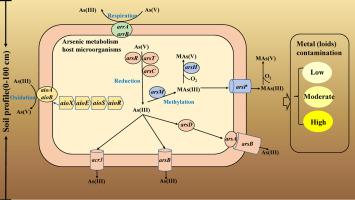Environmental Pollution ( IF 7.6 ) Pub Date : 2021-08-19 , DOI: 10.1016/j.envpol.2021.117994 Xianhong Li 1 , Xiaoxia Liu 2 , Neng Cao 1 , Songjun Fang 1 , Caihong Yu 1

|
Soil around the gold tailing due to the smelting process of wastewater and solid waste can lead to metal (loids) contamination, especially arsenic (As). Soil microorganisms have gradually evolved adaptive mechanisms in the process of long-term adaptation to As contamination. However, comprehensive investigations on As metabolism genes and their host microbial communities in soil profiles with different levels under long-term As contamination are lacking. There are selected three typical soil profiles (0–100 cm) with different metal (loids) contamination levels (L-low, M-moderate and H-high) around tailings in this research. It uses a Metagenomic approach to explore the adaptation mechanisms of arsenic metabolism genes and arsenic metabolism gene host microorganisms in both horizontal and vertical dimensions. The results showed that four categories of As metabolism genes were prevalent in soil profiles at different As contamination, with As reduction genes being the most abundant, followed by As oxidation genes, then respiration genes and methylation genes. The As metabolism genes arsBCR, aioE, arsPH, arrAB increased with the increase of metal (loid) contaminants concentration. Longitudinal arsA, arrA, aioA, arsM and acr3 increased in abundance in deep soil. Actinobacteria, Proteobacteria, Acidobacteria, and Chloroflexi were the dominant phylum of As metabolism gene host microorganisms. Different concentrations of metal (loid) contamination significantly affected the distribution of host As metabolism genes. Random forest prediction identified As as the most critical driver of As metabolism genes and their host microorganisms. Overall, this study provides a reference for a comprehensive investigation of the detoxification mechanisms of As metabolism microorganisms in soil profiles with different As contamination conditions, and is important for the development of As metabolism gene host microbial strains and engineering applications of microbial technologies to manage As contamination.
中文翻译:

弃金尾矿周围不同砷污染水平土壤中砷代谢基因及其宿主微生物的适应机制
由于废水和固体废物的冶炼过程,金尾矿周围的土壤会导致金属(类)污染,尤其是砷(As)。土壤微生物在长期适应砷污染的过程中逐渐进化出适应机制。然而,缺乏对长期砷污染下不同水平土壤剖面中砷代谢基因及其宿主微生物群落的综合研究。本研究选择了尾矿周围具有不同金属(类)污染水平(L-低、M-中和 H-高)的三种典型土壤剖面(0-100 cm)。它采用宏基因组方法从水平和垂直维度探索砷代谢基因和砷代谢基因宿主微生物的适应机制。结果表明,不同As污染的土壤剖面中普遍存在4类As代谢基因,其中As还原基因最丰富,其次是As氧化基因,然后是呼吸基因和甲基化基因。As代谢基因arsBCR , aioE , arsPH , arrAB随着金属(类)污染物浓度的增加而增加。纵向arsA、arrA、aioA、arsM和acr3在深层土壤中丰度增加。放线菌,变形菌,酸菌, 和Chloroflexi是砷代谢基因宿主微生物的优势门。不同浓度的金属(loid)污染显着影响宿主As代谢基因的分布。随机森林预测确定 As 是 As 代谢基因及其宿主微生物的最关键驱动因素。总体而言,本研究为全面研究不同砷污染条件土壤剖面中砷代谢微生物的解毒机制提供了参考,对砷代谢基因宿主微生物菌株的开发和微生物技术管理砷的工程应用具有重要意义。污染。











































 京公网安备 11010802027423号
京公网安备 11010802027423号